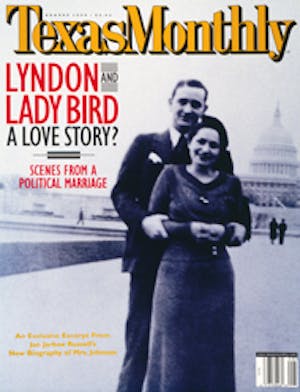The images that accompany this article in the August 1999 edition of Texas Monthly are not available online. For back issues and reprints contact “Back Issues”.
SOME PEOPLE DELIGHT IN IT, OTHERS RECOIL FROM IT, BUT NO ONE CAN ignore the work of Julie Speed. Clerics, flames, eyeballs, monkeys, and bones dominate her oil paintings, which might be described as the love children of a Magritte—van Eyck alliance; hyperfine brushstrokes, teeninesy details, and jewellike colors further rivet the eye. Small wonder the artist has earned her first major show, “Queen of My Room,” on view at the Austin Museum of Art through August 22. But Speed, in classic starving-artist tradition, labored for decades before her vision and technique coalesced into the distinctive, disturbing realm that today commands the attention of art lovers within Texas and without, including musicians Shawn Colvin and Jimmie Vaughan and actor Johnny Depp.
Born in 1951 in Chicago, Speed grew up all over New England. In childhood, she recalls, “I always drew. As I got older, my work got more and more detailed.” Sure enough, today her backgrounds often include hundreds of tiny designs—mysterious grids, spermatozoa, snippets of prose (“His body is a temple. His mind is an abandoned tuna canning factory”). The meticulous repetition soothes her, she says: “When I’m tense, I go into my head and paint grass.” When relatively plain, her backgrounds are often ominous: Tornadoes spin, skies lower, fires rage. Except for a brief fling with art school in the seventies, Speed is self-taught. “Back then the idea of art school was ‘Express yourself!’ It was a bad fit for me. I wanted to learn about materials and techniques. Now I realize it would have been really smart to pursue lessons—learning on my own took a lot of trial and error.” But the process also paid off, helping Speed to develop her style. Day jobs as a horse trainer, waitress, and merchandise stocker kept her in supplies.
A resident of Austin since 1978, Speed is a sweet-faced woman with a silvery voice and an unruly mane of graying brown hair. Behind her ranch-style West Austin home is a high-ceilinged studio built by her husband, drummer Fran Christina, who played with the late, lamented Fabulous Thunderbirds. She puts in up to twelve hours a day there. Outside, a singular garden sprouts equal profusions of six-foot sunflowers and rusty wrenches. Inside, summer sunlight pours in from above and Speed’s red-and-green parrot, Vito, surveys the room from his perch atop a table. Two dozen finished and unfinished artworks adorn the walls, including a couple of gouaches as well as assemblages variously bedecked with lace, thorns, nails, glass eyes, straight pins, and stones.
On the easel, awaiting final touches, is a portrait of a cardinal—Catholic variety. Speed is fascinated with things ecclesiastical. As a child, she pored endlessly over a book on world religions, which may also have inspired another hallmark, the addition of a third eye to human and animal subjects; she likes the ambivalence, she told Austin Museum of Art curator Elizabeth Ferrer, because “it sort of hurts your brain.” Equally unsettling are the bland, rosy faces that contrast sharply with the menacing backgrounds. Yet Speed also wants her art to be accessible, even inviting: “I hope people are laughing,” she says. “But making even one person question one little assumption would be the happiest result for me. And that’s a tall order.”







